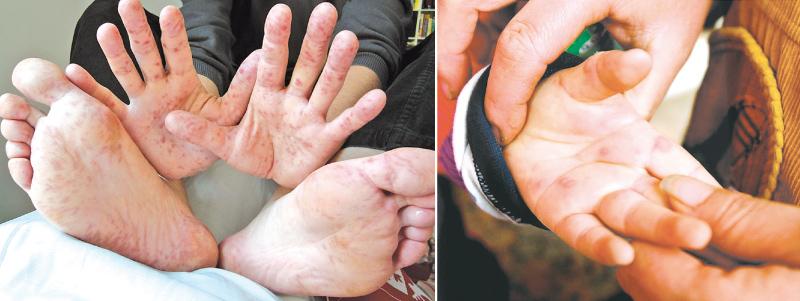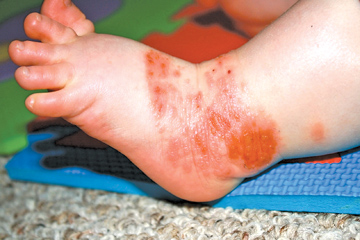
You may have heard of a disease called hand, foot and mouth disease in which a blistering rash that develops on hands including palms, on feet including soles, with fever and a sore throat often affecting children younger than five years.
The parents of the affected children might remember their nightmares seeing the children refusing meals and crying with painful ulcers. An increasing number of cases can be seen currently among children in schools, nurseries and daycare centers in Galle district and paediatricians and the general practitioners may have had experience in seeing patients from other parts of the country as well.
Hand, foot and mouth disease is an acute viral illness which presents as a blistering eruption in the so called areas. The child may present with high fever of 38-39 degree Celsius and refusal of solid food due to inflammation of the mouth and throat.
Then one or two days later, painful sores develop inside the mouth and small red spots with blisters can appear on the hands, feet, buttocks, and/or genitalia. Sometimes many body sites may get affected and can be mistaken as chickenpox.
Nurseries
 Coxsackievirus, a type 16 is the causative agent in most cases but some other types and viruses can also cause even outbreaks especially in nurseries, schools and childcare centers. The disease is prevalent in many parts of the world and in Asia large and frequent outbreaks occur mainly in summer and autumn.
Coxsackievirus, a type 16 is the causative agent in most cases but some other types and viruses can also cause even outbreaks especially in nurseries, schools and childcare centers. The disease is prevalent in many parts of the world and in Asia large and frequent outbreaks occur mainly in summer and autumn.
Infection generally occurs via the faecal-oral route or via contact with skin lesions and oral secretions. Hand, foot and mouth disease caused by coxsackievirus is generally a mild self-limited illness that resolves in 7-10 days. Rarely it can recur or persist. Severe neurological complications may occur but are very rare.
Though this is known as a childhood disease, even older children and adults acquire the virus rarely. Some people may remain asymptomatic despite the infection but able to pass the virus to others.
Severe oral ulcerations can be very painful and can interfere with oral intake and cause dehydration. The blisters in hands and feet can become secondarily infected with bacteria which may need antibiotics and longer duration to heal.
Generally, affected people are mostly contagious during the first week but can remain so for days or weeks even after the symptoms disappear. Therefore good personal hygiene is advised to reduce the virus spreading to others.
Advice to the parents
Seek medical attention if the child shows symptoms of the disease. The doctors will advice on the pain killers, on minimum requirement of fluids per hour to prevent dehydration and about nutrition.
Spicy or acidic meals may cause discomfort
Soft diet including soup, ice cream, mashed potato, jelly and yoghurt will improve appetite.
Fever may be treated with paracetamol
Ensure personal hygiene to prevent secondary infection of blisters. If ulceration occurs on hands and feet without evidence of secondary infection, then a mild antiseptic can be applied daily. Seek medical attention if there is severe ulceration on hands and feet or any evidence of secondary infection or neurological complications.
Keep the affected child away from the school till all blisters are healed to prevent the disease spread to others.
Practice good and strict hand hygiene during outbreaks which will help reduce transmission of the virus and to contain the outbreak.
Clean and disinfect frequently touched surfaces and toys. Avoid close contact such as kissing, hugging or sharing eating and drinking utensils with infected people.
(The writer is Consultant Microbiologist Teaching Hospital, Karapitiya, Galle.)
